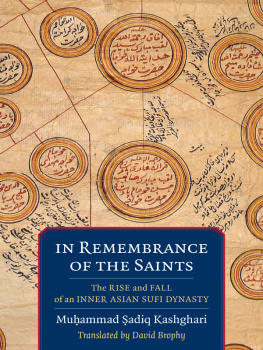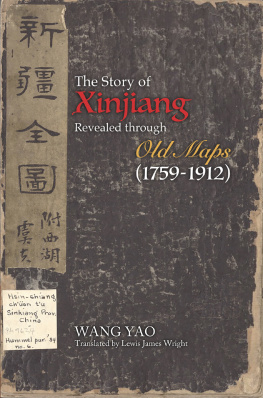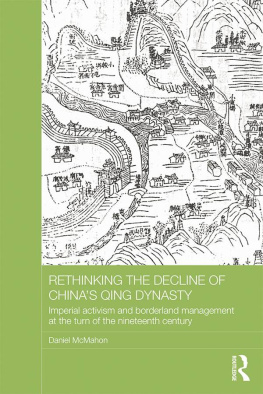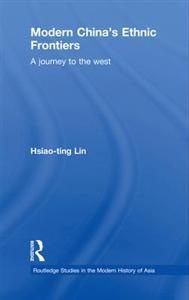Table of Contents
In Remembrance of
the Saints
TRANSLATIONS FROM THE ASIAN CLASSICS
Translations from the Asian Classics
Editorial Board:
Paul Anderer
Allison Busch
David Lurie
Rachel McDermott
Wei Shang
Haruo Shirane
In Remembrance of
the Saints
The Rise and Fall of an Inner
Asian Sufi Dynasty
M uammad adiq K ashghari
Translated by David Brophy
Columbia University Press
New York
This publication was made possible in part by an award from the James P. Geiss and Margaret Y. Hsu Foundation.
Columbia University Press
Publishers Since 1893
New YorkChichester, West Sussex
cup.columbia.edu
Copyright 2021 Columbia University Press
All rights reserved
EISBN 978-0-231-55252-3
Library of Congress Cataloging-in-Publication Data
Names: Kashghari, Muammad adiq, active 1780, author. |
Brophy, David John, translator.
Title: In remembrance of the saints : the rise and fall of an Inner Asian Sufi dynasty
/ Muammad adiq Kashghari ; Translated by David Brophy.
Other titles: Tazkira-yi azizan. English
Description: New York City : Columbia University Press, 2020. |
Series: Translations from the Asian classics |
Includes bibliographical references and index.
Identifiers: LCCN 2020028800 (print) | LCCN 2020028801 (ebook) |
ISBN 9780231198189 (hardback) | ISBN 9780231198196 (trade paperback) |
ISBN 9780231552523 (ebook)
Subjects: LCSH: SufisXinjiang Uygur Zizhiqu (China)Biography. |
SufismXinjiang Uygur Zizhiqu (China)History. | NaqshabandiyahAsia,
CentralHistory. | Xinjiang Uygur Zizhiqu (China)History.
Classification: LCC BP189.7.N35 K4513 2020 (print) | LCC BP189.7.N35 (ebook) |
DDC 297.4/8dc23
LC record available at https://lccn.loc.gov/2020028800
LC ebook record available at https://lccn.loc.gov/2020028801
A Columbia University Press E-book.
CUP would be pleased to hear about your reading experience with this e-book at .
Cover image: Section of a genealogical scroll of the
Naqshbandi Sufis of Xinjiang, circa 1800.
Cover design: Milenda Nan Ok Lee
Contents
T his translation is the product of a long, on-again off-again, engagement with Kashgharis work, and various friends and colleagues have helped along the way. I first began dabbling with In Remembrance of the Saints some fifteen years ago, when I was thinking about writing a dissertation on eighteenth-century Xinjiang. In the end, I set that topic aside, but this text remained with me. I was able to make a start on it thanks to the late Joseph Fletcher, who acquired copies of various manuscripts from European libraries for the collection of Harvards Widener Library. Bodleian MS Turk. d. 20, which I eventually took as my base text for this translation, was among them. Back then I had the great pleasure of reading sections with Wheeler Thackston, who took enough interest in it to convince me it was worth translating in full. Since then, his exemplary generosity has given me the encouragement and energy to continue the work.
Along the way Ive been able to examine manuscripts of In Remembrance of the Saints in the Bodleian and British Libraries, the Institute of Oriental Manuscripts in Saint Petersburg, the Jarring Collection in Lund, the Toyo Bunko in Tokyo, and most recently, at the Al-Beruni Institute of Oriental Studies in Tashkent. I want to thank the staff of all these institutions for facilitating my visits and allowing me to make copies when necessarythe Bodleian in particular for providing . Writing as I am from Covid quarantine in Sydney, I must also make mention of the ongoing digitization projects at Lund, and the Staatsbibliothek in Berlin, which have made Kashgharis work accessible to far-flung scholars such as myself. The great confinement of 2020 has made academics everywhere acutely aware of the value of such initiatives, and we pray they continue to receive the support they need.
After a long hiatus, I was able to return to this translation and complete it with the generous support of the Australian Research Councils Discovery Early Career Researcher Award for my project Empire and Religion in Early Modern Inner Asia (DE170100330). I want to thank Christine Dunbar at Columbia University Press who gave enthusiastic support to the book, and her colleagues who contributed to its editing and production. For sharing sources, offering improvements to the translation, and responding to various historical and linguistic inquiries, Id like to thank Eric Schluessel, Onuma Takahiro, Christopher Atwood, Morimoto Kazuo, Dan Sheffield, Rian Thum, and Najam Haider. Ying Qian has provided love and companionship throughout.
Sadly, this translation is being published at a time when the study of works such as Kashgharis is all but impossible inside China. Many Uyghur philologists, translators, and scholars of religion have vanished into Xinjiangs internment camps, and for all we know, some of them may well be languishing in prison. Of course, Ill be glad if this book contributes in some small way to raising the profile of the culture and language of the Uyghurs, though I dont pretend that this will do anything to change the dire situation they currently face. Its been a long time since Ive felt it was safe to communicate with colleagues and friends in Xinjiang, but Id like to acknowledge and pay my respects to the Uyghur language teachers who first set me on this path during my studies at Xinjiang University in 20022003. I can only hope that we can meet again one day in better times.
I n the middle of the eighteenth century, the Qianlong emperor of the Qing dynasty seized on an opportunity to do something that had long eluded his predecessors: eliminate the Manchu empires chief rival for control of Inner Asia, the Junghar Mongols. It was, in his view, the crowning achievement of his long reign, the highlight of a sustained period of imperial expansion that contemporaries saw as a flourishing age comparable to the height of the Han and Tang dynasties. In carrying out this campaign, the Qing not only established its uncontested rule across the Mongolian steppe but also made its decisive entry into Islamic Inner Asia. While the Junghars had occupied a domain of pastoral nomadism to the north of the Tianshan Mountains (todays Jungharia), to the south of that mountain range the Tarim Basin was home to an oasis society of Turkic-speaking Muslims, centered politically on the trading centers of Kashgar and Yarkand. Because these lands and their inhabitants had previously been loose vassals of the Junghars, the Qing now claimed them as their own. From that time until the present, with only brief interruptions, the Tarim Basin has remained subject to Beijings rule. Today it forms part of the Xinjiang Uyghur Autonomous Region, the vast northwestern territory of the Peoples Republic of China.
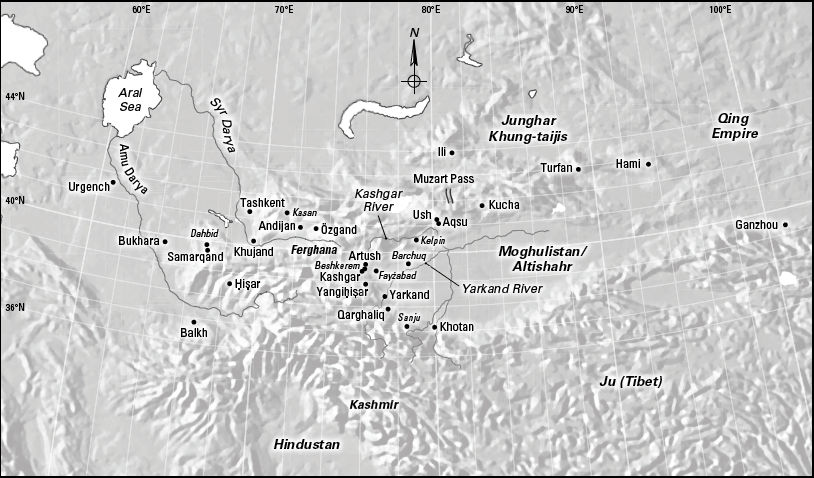
FIGURE 0.1 Map: China and Inner Asia in the eighteenth century.

